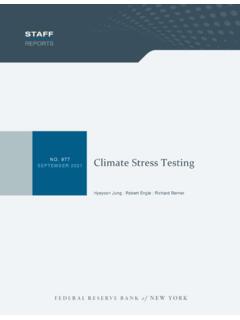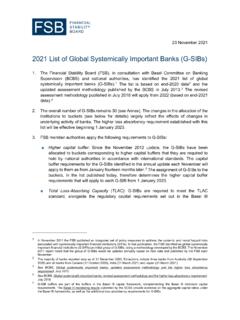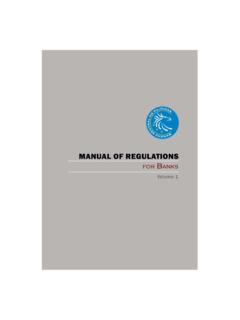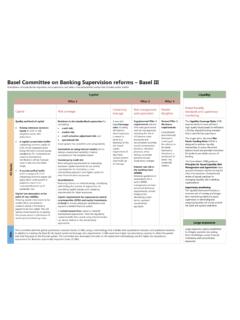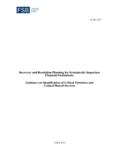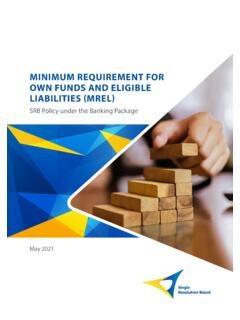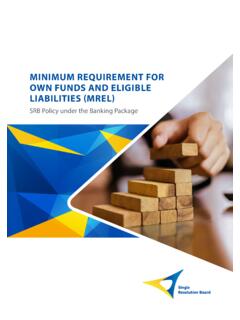Transcription of Basel Committee on Banking Supervision Standards
1 Basel Committee on Banking Supervision Standards Supervisory framework for measuring and controlling large exposures April 2014. This publication is available on the BIS website ( ). bank for International Settlements 2014. All rights reserved. Brief excerpts may be reproduced or translated provided the source is stated. ISBN 978-92-9197-987-5 (print). ISBN 978-92-9197-988-2 (online). Contents Abbreviations ..ii Supervisory framework for measuring and controlling large exposures .. 1. I. Introduction .. 1. A. Rationale and objectives of a large exposures 1. B. Other types of concentration risk .. 3. II. Overall design of a prudential framework for large exposures.
2 3. A. Scope and level of application .. 3. B. Scope of counterparties and exemptions .. 3. C. Definition of a large exposure and regulatory reporting .. 4. D. Minimum requirement the large exposure limit .. 4. E. Definition of connected counterparties .. 4. III. Values of exposures .. 6. A. General measurement principles .. 6. B. Definition of exposure value .. 6. C. Eligible credit risk mitigation (CRM) techniques .. 7. D. Recognition of CRM techniques in reduction of original exposure .. 8. E. Recognition of exposures to CRM providers .. 8. F. Calculation of exposure value for trading book positions .. 9.
3 G. Offsetting long and short positions in the trading book .. 10. IV. Treatment of specific exposure types .. 11. A. Sovereign exposures and entities connected with sovereigns .. 11. B. Interbank exposures .. 11. C. Covered bonds .. 12. D. Collective investment undertakings, securitisation vehicles and other structures .. 13. E. Exposures to central counterparties .. 15. V. Large exposures rules for global systemically important banks .. 16. VI. Implementation date and transitional 17. Supervisory framework for measuring and controlling large exposures i Abbreviations ABS Asset-backed securities CDO Collateralised debt obligation CDS Credit default swap CCF Credit conversion factor CIU Collective investment undertaking CCP Central counterparty CRM Credit risk mitigation D-SIB Domestic systemically important bank ECAI External credit assessment institution G-SIB Global systemically important bank G-SIFI Global systemically important financial institution IRB Internal ratings-based LTA Look-through approach OTC Over-the-counter PD Probability of default Q-CCP Qualifying central
4 Counterparty SA-CCR Standardised approach for counterparty credit risk SIFI systemically important financial institution SFT Securities financing transaction ii Supervisory framework for measuring and controlling large exposures Supervisory framework for measuring and controlling large exposures I. Introduction A. Rationale and objectives of a large exposures framework 1. One of the key lessons from the financial crisis was that banks did not always consistently measure, aggregate and control exposures to single counterparties or to groups of connected counterparties across their books and operations. Throughout history there have been instances of banks failing due to concentrated exposures to individual counterparties (eg Johnson Matthey Bankers in the United Kingdom in 1984, the Korean Banking crisis in the late 1990s).
5 Large exposures regulation has been developed as a tool for limiting the maximum loss a bank could face in the event of a sudden counterparty failure to a level that does not endanger the bank 's solvency. 2. The need for banks to measure and limit the size of large exposures in relation to their capital has long been recognised by the Basel Committee on Banking Supervision (the Committee ). In particular, in 1991, the Committee reviewed supervisory practices and issued supervisory guidance on large 1. exposures. In a similar vein, the Core Principles for Effective Banking Supervision (Core Principle 19). require that local laws and bank regulations set prudent limits on large exposures to a single borrower or 2.
6 A closely related group of borrowers. But neither the 1991 guidance nor the Core Principles set out how banks should measure and aggregate their exposures to a single counterparty, nor do they explain which factors should be taken into account when considering whether separate legal entities form a group of connected counterparties. This has resulted in a considerable variation of practice across the globe. A stocktake of Committee member countries' regulations of large exposures showed considerable homogeneity in general (consistent with Core Principle 19) but revealed material differences in important aspects such as: scope of application; the value of large exposure limits; the definition of capital on which limits were based; methods for calculating exposure values; treatment of credit risk mitigation techniques; and whether certain types of exposures were subject to more lenient treatments.
7 3. A large exposures framework complements the Committee 's risk-based capital standard because the latter is not designed specifically to protect banks from large losses resulting from the sudden default of a single counterparty. In particular, the minimum capital requirements (Pillar 1) of the Basel risk-based capital framework implicitly assume that a bank holds infinitely granular portfolios, ie no form of concentration risk is considered in calculating capital requirements. Contrary to this assumption, idiosyncratic risk due to large exposures to individual counterparties may be present in banks' portfolios.
8 Although a supervisory review process (Pillar 2) concentration risk adjustment could be made to mitigate 1. The first Basel Committee guidance on this topic, Measuring and controlling large credit exposures, was published in January 1991 in an attempt to increase convergence in the Supervision of large exposures while recognising the scope for variation according to local conditions. This best practice for bank supervisors in the monitoring and controlling of large credit exposures was developed in the context of the Standards in Basel I. It included numerical limits as a percentage of Basel I. capital, the definition of which has been subsequently revised in later vintages of the Basel capital framework and more recently and substantively in Basel III.
9 2. Principle 19 states The supervisor determines that banks have adequate policies and processes to identify, measure, evaluate, monitor, report and control or mitigate concentrations of risk on a timely basis. Supervisors set prudential limits to restrict bank exposures to single counterparties or groups of connected counterparties. (The Core Principles for Effective Banking Supervision , published by the Committee in September 2012, are accessible at ). Supervisory framework for measuring and controlling large exposures 1. 3. this risk, these adjustments are neither harmonised across jurisdictions, nor designed to protect a bank against very large losses from a single counterparty default.
10 For this reason, the Committee has concluded that the existing risk-based capital framework is not sufficient to fully mitigate the microprudential risk from exposures that are large compared to a bank 's capital resources. That framework needs to be supplemented with a simple large exposures framework that protects banks from traumatic losses caused by the sudden default of an individual counterparty or group of connected counterparties. To serve as a backstop to risk-based capital requirements, the large exposures framework should be designed so that the maximum possible loss a bank could incur if a single counterparty or group of connected counterparties were to suddenly fail would not endanger the bank 's survival as a going concern.










